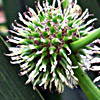Sparganium erectum is a tall herbaceous perennial plant that emerges straight out of the water. It reaches a height of up to one and a half meters and at first glance resembles the Poaceae or the Cyperaceae. The stem is round and hollow. It divides at its upper end into several inflorescence scapes. It develops a creeping rhizome inside the mud at the bottom, and additional shoots arise from its nodes in vegetative reproduction, such that clumps of plants are created. The leaves are linear, long, erect, rigid, with delicately dentated margins. They are sharp and injurious. The leaves are arranged in two rows. The lower leaves are ribbed-triangular and the upper ones are flat.
Sparganium erectum blooms from March to July. The inflorescence is a spherical-spurred capitulum. The flowers are unisexual, but male and female flowers appear on the same individual: the capituli of male flowers in the axil of leaves at the head of the stem, capituli of female flowers in the axil of leaves in the middle part of the stem. There are three flower organs in each whorl, and they are green, small, pollinated by wind or by pollen-seeking insects. The female inflorescences ripen before the male inflorescences. The fruits ripen in the autumn, and are arranged in groups of balls along the stems. The fruit is spherical and rough, composed of swollen units with a beak at their head.
Sparganium erectum grows in or near water, in marshes and streams, mainly in a muddy bottom in clear water with a depth of 20 cm. It is rare in Israel, and has become even rarer in the past decades. It is found in the valleys of the north, mainly in the Golan Heights, the Hula and in the Sharon region. In Israel the populations are few, small and fragmented, and it is considered a plant in danger of becoming extinct nationally. Its global distribution spreads over watery Mediterranean landscapes in a broad area around the Mediterranean Sea and further to the north and east. Its habitat serves as a living and nesting site for water birds, and as food for others. The seed is edible also to man. There are places where its vigorous reproduction causes the clogging of channels.
This genus includes 14 species that are common around the world. It used to be classified in a monogenic family of its own but it is considered now as part of the Typhaceae family.
Written by Mike Livne





